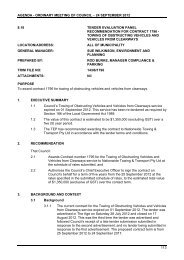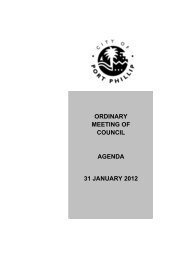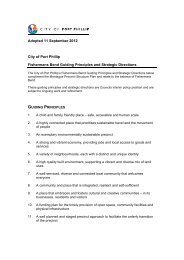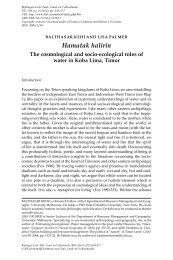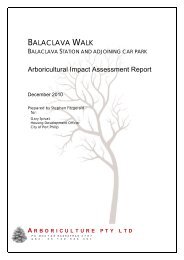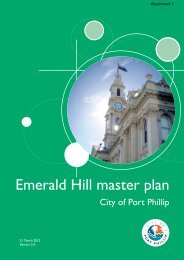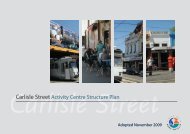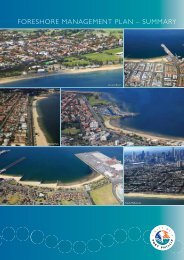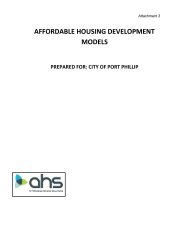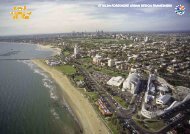Review of Heritage Overlay 1 Port Melbourne ... - City of Port Phillip
Review of Heritage Overlay 1 Port Melbourne ... - City of Port Phillip
Review of Heritage Overlay 1 Port Melbourne ... - City of Port Phillip
You also want an ePaper? Increase the reach of your titles
YUMPU automatically turns print PDFs into web optimized ePapers that Google loves.
1.0 Introduction<br />
The <strong>Review</strong> <strong>of</strong> <strong>Heritage</strong> <strong>Overlay</strong> 1 (<strong>Port</strong> <strong>Melbourne</strong>) was undertaken in 2011 by Lovell Chen<br />
Architects and <strong>Heritage</strong> Consultants for the <strong>City</strong> <strong>of</strong> <strong>Port</strong> <strong>Phillip</strong>.<br />
This summary report outlines the rationale and methodology utilised in the review. The<br />
report presents the conclusions and recommendations <strong>of</strong> the review, including<br />
recommendation for amendments to the boundaries <strong>of</strong> HO1 and for the establishment <strong>of</strong><br />
sub-precincts within HO1. Draft citations and statements <strong>of</strong> significance for the identified<br />
sub-precincts have been prepared and attached for inclusion in the <strong>Port</strong> <strong>Phillip</strong> <strong>Heritage</strong><br />
<strong>Review</strong> through a future planning scheme amendment.<br />
1.1 Project background<br />
<strong>Heritage</strong> <strong>Overlay</strong> 1 (also referred to throughout this report as HO1) covers a broad area <strong>of</strong><br />
<strong>Port</strong> <strong>Melbourne</strong>, including the Bay Street commercial area, surrounding residential<br />
neighbourhoods and some limited industrial development concentrated near the foreshore.<br />
The current statement <strong>of</strong> significance for the precinct, as contained in the <strong>Port</strong> <strong>Phillip</strong><br />
<strong>Heritage</strong> <strong>Review</strong> (an incorporated document to the <strong>Port</strong> <strong>Phillip</strong> Planning Scheme), reflects the<br />
broadness and diversity <strong>of</strong> built form found within the area and is as follows:<br />
The <strong>Port</strong> <strong>Melbourne</strong> Area encompasses the long established residential and<br />
commercial streets <strong>of</strong> <strong>Port</strong> <strong>Melbourne</strong> commencing at Pickles Street in the<br />
south and finishing at Clark Street in the north. It has historical<br />
importance (Criterion A) as a nineteenth century working class area<br />
associated with the growth <strong>of</strong> the <strong>Port</strong> <strong>of</strong> <strong>Melbourne</strong> and especially the<br />
bayside shipping activities <strong>of</strong> the port and with the industrial development<br />
<strong>of</strong> the shore line last century and the Yarra River flats this century. This<br />
importance is demonstrated not only by the housing stock and surviving<br />
industrial establishments but also by the diversity <strong>of</strong> commercial and<br />
public buildings within the Area. The Area is especially valuable for its<br />
capacity to demonstrate the life style <strong>of</strong> this close knit community during<br />
the nineteenth century. Being surrounded by industrial land, the Bay and<br />
the Lagoon reserves, the Area retains its discrete geographical form and<br />
has value for its capacity to demonstrate past urban planning practices<br />
characteristic <strong>of</strong> the pre-automobile age. These include the Bay street<br />
strip shopping centre, the railway gardens and other reserves, the status<br />
given to public buildings and public transport services and the mix <strong>of</strong><br />
residential and non-residential uses wherein street corner sites are<br />
invariably occupied by hotels and shops establishing a distinctive<br />
streetscape pattern.<br />
The current review is intended to ensure the continued relevance and comprehensiveness <strong>of</strong><br />
the <strong>Heritage</strong> <strong>Overlay</strong> (HO) controls in <strong>Port</strong> <strong>Melbourne</strong>, through both the assessment <strong>of</strong> five<br />
specific areas not currently included in HO1 and the identification <strong>of</strong> smaller, more consistent<br />
sub-precincts within the existing HO1 precinct.<br />
The key tasks identified in the Project Brief were as follows:<br />
<br />
<br />
<br />
Part 1 <strong>Review</strong> and assess selected areas for possible inclusion in HO1<br />
(Areas 1-5 identified on maps provided by Council)<br />
Part 2 <strong>Review</strong> and make recommendations in relation to the existing<br />
boundaries <strong>of</strong> HO1<br />
Part 3 <strong>Review</strong> the current grading / planning control <strong>of</strong> a list <strong>of</strong> identified<br />
properties within HO1 (list provided by Council)<br />
L O V E L L C H E N 1



